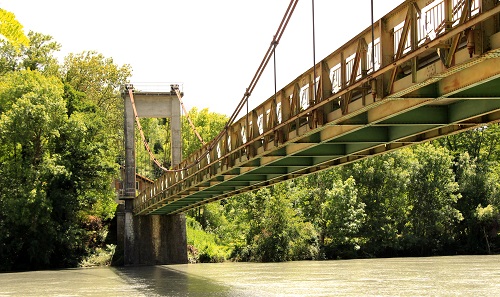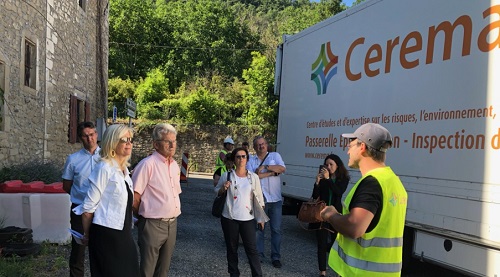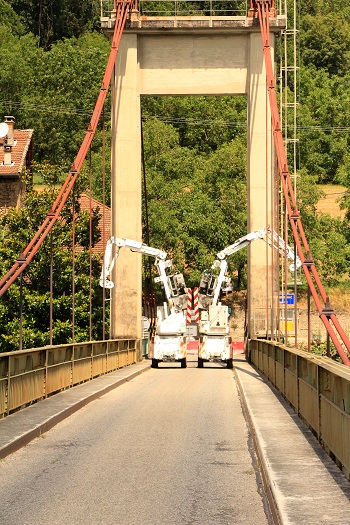
Cerema is renowned for its expertise on this type of structure (knowledge of how it functions, the pathologies, the means of examination and inspection). It provides the following services: detailed periodic inspection by means of the Epsilon suspended platform, examination of the cables, assessment of anti-corrosion paint and safety analysis of loads borne by the suspension.
The Eymeux suspension bridge enables the RD325 road to cross the Isère river. It is close to the borders of the Isère and Drôme départements, and is managed by the Departmental Council of Drôme.
A detailed multi-disciplinary inspection

The Departmental Council decided to carry out an investigation and inspection campaign on the structure in order to identify the works to be carried out.
Cerema’s expertise on this type of structure is based on wide-ranging knowledge of such structures: their design (varying depending on the period of construction), the methods for calculating the design of each structural component, the specificities of the materials used in each era of construction and the associated risks (“fragile” steels in particular), the recurring problems on this type of structure, the methods for investigation, the inspection techniques (ropes, platforms).
Thanks to all these skills brought together and used on many different projects, Cerema is an irreplaceable player when it comes to management of suspension bridges, and is characterised by a collegial approach and sharing of experience. Cerema offered the following services:
-
detailed periodic inspection, using the Epsilon suspended platform
-
examination of the cables
-
assessment of the anti-corrosion paint
-
safety analysis of the loads in the suspension.
These services were provided between December 2019 and July 2020
A summarising document will include conclusions from the different activities, and will make proposals for additional investigations and the works that should be carried out.

On Monday 6 July 2020 the campaign began in the presence of elected representatives from the départements of Drôme and Isère: Emmanuelle Antoine, deputy and departmental councillor, André Gilles, vice-president of the Departmental Council of Drôme, Bernard Perazio, vice-president of the Departmental Council of Isère, as well as Fabrice Bar the mayor of Eymeux, who witnessed the setting up of the campaign by the Cerema teams.
Pascal Berteaud, Director General of Cerema and Séverine Bourgeois, Director of Cerema Centre-Est, were also present.
Access to complex engineering structures thanks to Cerema’s suspended platform, Epsilon

Cerema’s suspended platform, Epsilon, is the only way to gain access to structures with an exceptional or strategic dimension. It enables the teams to enter into physical contact with bridges for monitoring activities, investigation, detailed inspection and to carry out routine or specialised maintenance operations.
It can be installed in less than 2 hours, and is deployed in mainland France by Cerema. Its width can be modified from 6 to 18 metres. It can carry two people in addition to the operator, and is accompanied by a boat for underwater operations.
Detailed inspection of bridges is a crucial part of asset management, described by specific regulations (technical instruction for monitoring and maintenance of engineering structures - ITSEOA), and plays an important role in guaranteeing the effectiveness of management policies.
Thanks to the structural assessment of the bridge, the information obtained from the detailed inspection makes it possible to define and plan preventive maintenance operations, and if necessary any specific monitoring actions, additional investigations or repair work.
Accordingly the inspection report presents a preliminary assessment of the current condition of the bridge and makes recommendations for investigations, actions to take for user safety and maintenance of the bridge.
At Eymeux, it would not have been possible to carry out part of this inspection without the Epsilon platform. The lightweight platform enables the Cerema inspector to gain access to the whole of the arch intrados, and to carry out the inspection in physical contact with the structure, as recommended by the regulations.

